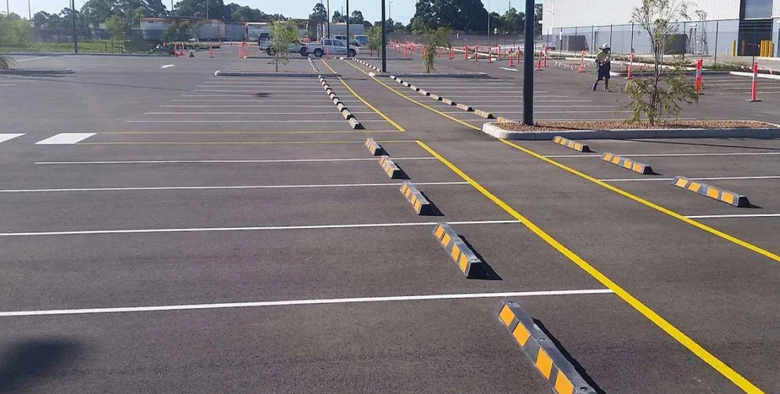Every customer deserves the same easy path from the car to the front door. That’s why the Americans with Disabilities Act (ADA) sets clear rules for parking lots. You might wonder, “Does my lot follow those rules today?”
- Count your total spaces and confirm you have enough accessible ones.
- Make sure each accessible space is wide enough and has an access aisle.
- Provide at least one van-accessible space with extra width or aisle.
- Mount the blue wheelchair sign so its bottom edge sits 5 feet above the ground.
- Keep the route from each accessible space to the entrance smooth and free of obstacles.
In this blog, you’ll see a simple table, step-by-step checks, common mistakes, and quick fixes so you can feel confident that your lot stays on the right side of the law.
Why ADA Compliance Matters
ADA violations can lead to fines of up to $75,000 for a first offense and civil lawsuits that cost far more. Even one barrier can stop a shopper using a wheelchair from entering your business.
The ADA is federal law, but state or local codes can add stricter rules. Always double-check local requirements.
Quick Numbers At A Glance
Before we dive into each checkpoint, use this table to see how many accessible spots you need.
| Total spaces in the lot | Minimum accessible spaces | Of those, van-accessible |
| 1–25 | 1 | 1 |
| 26–50 | 2 | 1 |
| 51–75 | 3 | 1 |
| 76–100 | 4 | 1 |
| 101–150 | 5 | 1 |
If your lot has more than 150 spaces, add one accessible space for every extra 50 spots, and make 1 in 6 of all accessible spaces van-accessible.
Step-By-Step Checklist
- Count Your Spaces
Start by counting every standard, compact, and reserved stall. The number drives every other rule, so get it right.
Quick Tip: Include employee parking. The ADA counts spaces used by anyone.
- Measure the Width
- Standard accessible space: 8 ft wide with a 5 ft access aisle.
- Van-accessible option 1: 11 ft wide with a 5 ft aisle.
- Van-accessible option 2: 8 ft wide plus an 8 ft aisle.
Use a tape measure. Paint ages, so confirm the usable width, not just the faded lines.
- Check the Access Aisles
Access aisles must be as long as the space, clearly striped, and slope no more than 1:48 (about 2%). The aisle lets a wheelchair user lower a lift or open a van door.
A steep aisle is the most common ADA slip-up. If water pools or cars roll when parked, your slope is too steep.
- Inspect Each Sign
- The International Symbol of Accessibility must be visible even when a van is parked.
- Mount the sign so its bottom edge is at least 60 inches above the ground.
- Van spaces need the added “Van Accessible” plaque.
- Verify Surface Condition and Markings
Lines must be easy to see. Cracked asphalt or faded paint confuses drivers, leading to illegal parking in accessible spots.
If lines look worn, call South Park Striping to refresh them before someone complains.
Confirm the Route to the Entrance
The path from every accessible space to the building must be:
- At least 3 ft wide.
- Free of steps or curbs, unless a ramp is provided.
- Slip-resistant and stable.
Doors at the end of the route need 32 inches of clear width when open.
Common Mistakes and How To Fix Them
- Using accessible spaces for storage
Move the pallets or dumpsters immediately.
- Placing signs too low
Remount at the required height.
- Providing no access aisle for the van space
Re-stripe to add the aisle; do not shrink the aisle below ADA width.
- Allowing slopes to creep over time
Grind or re-pave to restore a gentle grade.
- Missing tactile warning at curb ramp ends
Install the yellow truncated-dome panels.
Fact: A single broken sign can trigger a complaint that brings inspectors to survey your entire property.
When to Call a Professional
If you plan major resurfacing, expand the lot, or move entrances, hire an architect or civil engineer who knows ADA parking rules. They can review drawings and spot issues before the first truck rolls in.
Conclusion
Staying ADA compliant is easier when you break it into small checks: enough spaces, right widths, clear signs, gentle slopes, and safe routes. Spend a morning with a tape measure and a clipboard. Fix anything you find right away. Your customers will thank you, and you’ll sleep better knowing fines and lawsuits are off the table. For fresh, sharp lines, consider South Park Striping—we paint ADA layouts every day.

